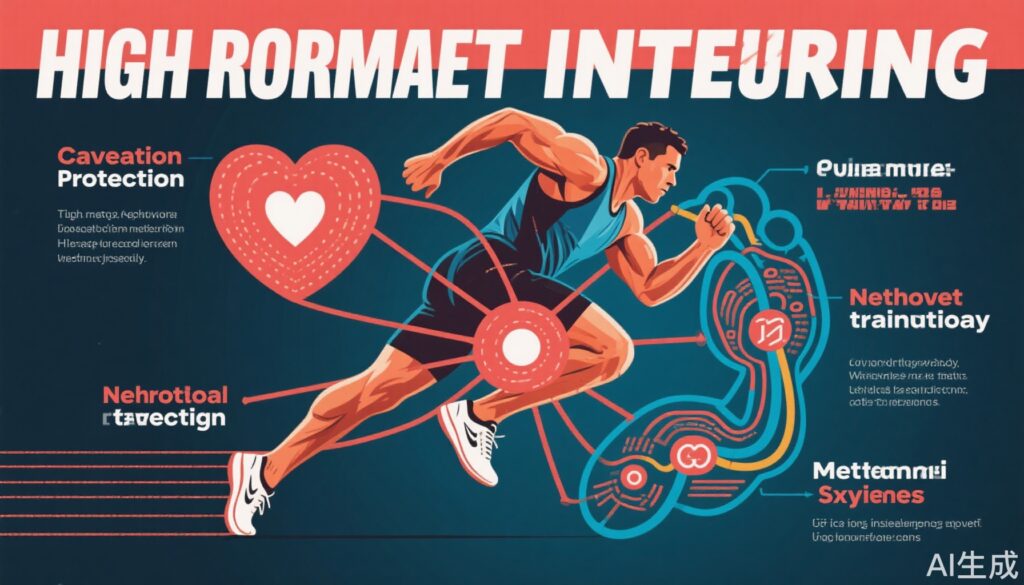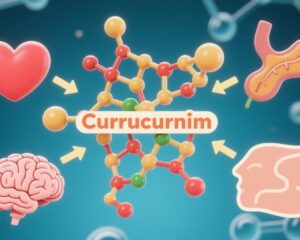Highlights
- HIIT improves cardiovascular function by enhancing aerobic capacity, cardiac remodeling, and vascular health in diverse populations including older adults, type 2 diabetes patients, and heart transplant recipients.
- HIIT induces beneficial neuropsychological outcomes such as improved quality of life, depression, and anxiety in patients with coronary artery disease, with in-person delivery yielding greater benefits than home-based programs.
- HIIT favorably modulates metabolic parameters including insulin sensitivity, pancreatic fat content, glycemic control, and lipid metabolism through molecular and epigenetic mechanisms.
- Exercise-induced epigenetic reprogramming, notably DNA methylation changes in genes like p66Shc, may underpin vascular and oxidative stress improvements, linking HIIT to anti-ageing effects at molecular levels.
Background
Cardiovascular disease (CVD), metabolic syndrome, and neuropsychiatric disorders represent leading causes of morbidity and mortality worldwide. Conventional moderate-intensity continuous training (MICT) has been widely recommended to mitigate these risks, but high-intensity interval training (HIIT) has gained attention for its potential superior effects and time efficiency. This review integrates findings from randomized controlled trials (RCTs), meta-analyses, and mechanistic studies clarifying the protective role of HIIT on cardiovascular, neural, and metabolic health, addressing diverse clinical contexts from coronary artery disease to type 2 diabetes mellitus (T2DM) and ageing.
Key Content
Cardiovascular Protection
Several RCTs have established HIIT’s ability to improve peak oxygen uptake (VO2peak), a proxy for aerobic capacity and cardiovascular fitness. For instance, the Scandinavian de novo heart transplant (HTx) trial (NCT01796379) demonstrated that 9 months of HIIT, compared with moderate-intensity continuous training (MICT), significantly increased VO2peak by approximately 1.8 mL·kg-1·min-1 (25% vs. 15% improvement) alongside improved anaerobic threshold and muscular power (Laursen et al., 2019, PMID: 30773030). Similarly, patients with T2DM following 12 weeks of HIIT showed improved cardiac structure and function, as evaluated by MRI, including increased left ventricular wall mass and stroke volume, with concurrent substantial reductions in liver fat and HbA1c (Weston et al., 2016, PMID: 26350611).
The Generation 100 trial (NCT01666340) involving older adults (70-77 years) randomized to 5 years of HIIT or MICT reported modest increases in VO2peak with HIIT but no significant reduction in a continuous cardiovascular risk score or major cardiovascular events, possibly reflecting the study’s healthy and fit cohort (Patel et al., 2022, PMID: 34746955). Nonetheless, HIIT showed superiority in some individual cardiovascular risk factors.
Vascular health is improved by HIIT in individuals with T2DM irrespective of improvements in cardiorespiratory fitness, as 1-year exercise interventions reduced carotid intima-media thickness and peripheral arterial stiffness in both responders and non-responders to cardiorespiratory fitness improvements (Paiva et al., 2020, PMID: 31960071). At the molecular level, HIIT induced epigenetic modifications in p66Shc gene promoter methylation and reduced oxidative stress markers, correlating with normalization of retinal microvascular diameters in aged subjects with cardiovascular risk, thus linking vascular remodeling with epigenetic reprogramming (Gioscia-Ryan et al., 2020, PMID: 31323685).
Neurological and Mental Health Benefits
A comprehensive network meta-analysis including 42 RCTs in patients with coronary artery disease reported significant improvements in health-related quality of life (HR-QoL), depression, and anxiety following exercise training. HIIT alone and HIIT plus resistance training (HIIT+R) yielded greater HR-QoL improvements than moderate-intensity training (MIT) or stretching exercises. Moreover, in-person supervised exercise exhibited superior efficacy compared to home-based programs in ameliorating depressive and anxiety symptoms (Danylchenko et al., 2025, PMID: 39809303).
Though limited data exist on direct effects of HIIT on cognition and brain structure, improved depression and anxiety scores suggest indirect neuropsychological benefits. The integration of exercise into lifestyle interventions may thus contribute to better mental health outcomes alongside physical health improvements.
Metabolic Effects and Glycemic Control
HIIT exerts significant metabolic benefits including improved insulin sensitivity, pancreatic beta cell function, and reductions in ectopic fat deposition. A randomized trial (NCT01344928) showed decreased pancreatic fat content and enhanced beta cell function irrespective of prediabetes or T2DM status after 2 weeks of sprint interval or moderate-intensity training (Van Raalte et al., 2018, PMID: 29717337). Similarly, a substudy of the EX-MET trial revealed that higher-volume HIIT (four 4-minute bouts per session) reduced circulating intact proinsulin levels—a marker of beta cell dysfunction—in metabolic syndrome subjects without T2DM, signifying improved insulin quality (Jelleyman et al., 2016, PMID: 27480182).
In overweight/obese women, combining time-restricted eating (TRE) with HIIT produced superior reductions in HbA1c and visceral fat mass relative to either intervention alone, although the primary outcome of glucose area under the curve was not significantly changed (Parr et al., 2022, PMID: 36198292).
Timing of HIIT may influence metabolic benefits; evening HIIT partially reversed high-fat diet-induced metabolomic perturbations and improved nocturnal glycemic control more effectively than morning HIIT in overweight men, highlighting circadian considerations in exercise prescription (Qin et al., 2021, PMID: 34009435).
Studies in adults with type 1 diabetes showed that while overall HbA1c reductions with HIIT were modest and not statistically different from controls, greater adherence to HIIT was associated with significantly improved glycemic control without increased hypoglycemia risk (Yardley et al., 2020, PMID: 32647051). Notably, paradoxical increases in hypoglycemia symptoms during HIIT despite hyperglycemia suggest complex glucose perception challenges during exercise in this population (Suarez et al., 2019, PMID: 31391201).
Molecular and Translational Insights
Proteomic analyses reveal that HIIT reverses many age-related declines in mitochondrial protein expression and stimulates mitochondrial protein synthesis in skeletal muscle, explaining gains in aerobic capacity and insulin sensitivity in younger and older adults (Robinson et al., 2017, PMID: 28273480). DNA methylation changes at key oxidative stress genes parallel vascular improvements, suggesting epigenetic regulation as a mechanistic substrate for HIIT’s benefits (Gioscia-Ryan et al., 2020).
HIIT also decreases hepatic very low-density lipoprotein (VLDL)-triglyceride secretion rate, lowering fasting triglycerides through reduced hepatic lipid output rather than increased clearance, which contributes to improved lipid profiles (Bergman et al., 2008, PMID: 18664593).
Expert Commentary
The accumulated evidence indicates that HIIT is a robust intervention for improving cardiovascular fitness, vascular function, metabolic control, and mental health across diverse clinical populations. Although some large-scale and longer-term studies (e.g., Generation 100) have observed modest effects on composite cardiovascular risk scores, benefits at organ and molecular levels are evident. Challenges include variable adherence, variability of responses, and feasibility particularly in advanced heart failure or post-transplant populations.
Supervised, in-person HIIT programs appear superior in improving mental health outcomes, highlighting the importance of behavioral and psychosocial factors in exercise prescription. The circadian timing of exercise may modulate metabolic responses, inviting personalized approaches.
Molecular studies underscore epigenetic and proteomic adaptations that sustain the phenotypic improvements seen clinically, suggesting exercise functions as a multi-level modulator impacting aging, oxidative stress, and metabolic regulation pathways. However, further research is warranted to elucidate sex differences, long-term adherence, and integration with dietary interventions.
Conclusion
High-intensity interval training exerts multifaceted protective effects on the cardiovascular system, neurological health, and metabolism. It improves aerobic capacity, cardiac and vascular function, reduces ectopic fat accumulation, optimizes glycemic control, and attenuates symptoms of depression and anxiety, with underlying molecular adaptations. Future research should refine dosing strategies, maximize adherence, and integrate personalized factors such as exercise timing and combination with dietary regimens to fully leverage HIIT in preventive and therapeutic frameworks.
References
- Danylchenko et al. Exercise type and settings, quality of life, and mental health in coronary artery disease: a network meta-analysis. Eur Heart J. 2025;46(23):2186-2201. PMID: 39809303
- Parr et al. Time-restricted eating and exercise training improve HbA1c and body composition in women with overweight/obesity: A randomized controlled trial. Cell Metab. 2022;34(10):1457-1471.e4. PMID: 36198292
- Patel et al. Effect of 5 years of exercise training on the cardiovascular risk profile of older adults: the Generation 100 randomized trial. Eur Heart J. 2022;43(21):2065-2075. PMID: 34746955
- Qin et al. The effect of morning vs evening exercise training on glycaemic control and serum metabolites in overweight/obese men: a randomised trial. Diabetologia. 2021;64(9):2061-2076. PMID: 34009435
- Yardley et al. Effect of High-Intensity Interval Training on Glycemic Control in Adults With Type 1 Diabetes and Overweight or Obesity: A Randomized Controlled Trial With Partial Crossover. Diabetes Care. 2020;43(9):2281-2288. PMID: 32647051
- Gioscia-Ryan et al. High-intensity interval training modulates retinal microvascular phenotype and DNA methylation of p66Shc gene: a randomized controlled trial (EXAMIN AGE). Eur Heart J. 2020;41(15):1514-1519. PMID: 31323685
- Paiva et al. Vascular improvements in individuals with type 2 diabetes following a 1 year randomised controlled exercise intervention, irrespective of changes in cardiorespiratory fitness. Diabetologia. 2020;63(4):722-732. PMID: 31960071
- Laursen et al. Effect of High-Intensity Interval Training in De Novo Heart Transplant Recipients in Scandinavia. Circulation. 2019;139(19):2198-2211. PMID: 30773030
- Van Raalte et al. Exercise training decreases pancreatic fat content and improves beta cell function regardless of baseline glucose tolerance: a randomised controlled trial. Diabetologia. 2018;61(8):1817-1828. PMID: 29717337
- Robinson et al. Enhanced Protein Translation Underlies Improved Metabolic and Physical Adaptations to Different Exercise Training Modes in Young and Old Humans. Cell Metab. 2017;25(3):581-592. PMID: 28273480
- Weston et al. High intensity intermittent exercise improves cardiac structure and function and reduces liver fat in patients with type 2 diabetes: a randomised controlled trial. Diabetologia. 2016;59(1):56-66. PMID: 26350611
- Jelleyman et al. The effect of different volumes of high-intensity interval training on proinsulin in participants with the metabolic syndrome: a randomised trial. Diabetologia. 2016;59(11):2308-2320. PMID: 27480182
- Bergman et al. High-intensity interval aerobic training reduces hepatic very low-density lipoprotein-triglyceride secretion rate in men. Am J Physiol Endocrinol Metab. 2008;295(4):E851-8. PMID: 18664593
- Suarez et al. Paradoxical Rise in Hypoglycemia Symptoms With Development of Hyperglycemia During High-Intensity Interval Training in Type 1 Diabetes. Diabetes Care. 2019;42(10):2011-2014. PMID: 31391201



